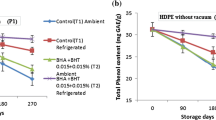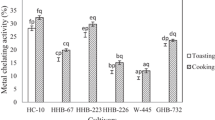Abstract
This study presents the effects of soaking, cooking and industrial dehydration on the phenolic profile, and antioxidant capacity in two chickpea varieties (Sinaloa and Castellano). Chromatographic analysis identified a total of 24 phenolic components, being isoflavones the main phenolics in raw and processed Sinaloa and Castellano flours. The impact of the industrial dehydration was different depending on the chickpea variety. Although Castellano chickpea exhibited the highest levels of phenolic compounds (103.1 μg/g), significant reductions were observed during processing; in contrast, the dehydration did not cause any further effects in Sinaloa flours. Interestingly, Sinaloa variety showed high thermal stability of isoflavones during processing. As expected, the levels of antioxidant capacity were in accordance with the behavior of phenolic compounds exhibiting noticeable reductions in Castellano chickpea and not relevant changes in Sinaloa chickpea. Thus, the significant occurrence of bioactive phenolic compounds along with the relevant antioxidant capacities of dehydrated chickpea flours make them to be considered functional ingredients for their beneficial health effects, especially in case of Sinaloa.


Similar content being viewed by others
Abbreviations
- AUC:
-
Area under the fluorescence decay curve
- DMRT:
-
Duncan’s multiple range test
- ESI:
-
Electrospray ionization
- ORAC:
-
Oxygen radical absorbing capacity assay
- PAD:
-
Photodiode-array detector
- PCA:
-
Principal component analysis
- S:
-
Soaked
- S+C:
-
Soaked+cooked
- S+C+D:
-
Soaked+cooked+dehydrated
References
FAO Statistics (2008) Productions, crops. Retrieved September 15, 2010 from http://faostat.fao.org/site/567/DesktopDefault.aspx?PageID=567#ancor
Thomasset SC, Berry DP, Garcea G, Marczylo T, Steward WP, Gescher AJ (2007) Dietary polyphenolic phytochemicals—promising cancer chemopreventive agents in humans? A review of their clinical properties. Int J Cancer 120(3):451–458
Yang CS, Landau JM, Huang MT, Newmark HL (2001) Inhibition of carcinogenesis by dietary polyphenolic compounds. Annu Rev Nutr 21:381–406
Xu BJ, Chang SKC (2010) Phenolic substance characterization and chemical and cell-based antioxidant activities of 11 lentils grown in the northern United States. J Agric Food Chem 58(3):1509–1517
Ryan E, Galvin K, O’Connor TP, Maguire AR, O’Brien NM (2007) Phytosterol, squalene, tocopherol content and fatty acid profile of selected seeds, grains, and legumes. Plant Foods Hum Nutr 62(3):85–91
Cassidy A, Albertazzi P, Lise Nielsen I, Hall W, Williamson G, Tetens I, Atkins S, Cross H, Manios Y, Wolk A, Steiner C, Branca F (2006) Critical review of health effects of soyabean phyto-oestrogens in postmenopausal women. Proc Nutr Soc 65(1):76–92
Sreerama YN, Shashikala VB, Pratape VM (2010) Variability in the distribution of phenolic compounds in milled fractions of chickpea and horse gram: Evaluation of their antioxidant properties. J Food Agric Chem 58(14):8322–8330
Aguilera Y, Martín-Cabrejas MA, Benítez V, Mollá E, López-Andréu FJ, Esteban RM (2009) Changes in carbohydrate fraction during dehydration process of common legumes. J Food Compos Anal 22(7–8):678–683
Aguilera Y, Esteban RM, Benítez V, Mollá E, Martín–Cabrejas MA (2009) Starch, functional properties and microstructural characteristics in chickpea and lentil as affected by thermal processing. J Agric Food Chem 57(2):10682–10688
Satwadhar PN, Kadam SS, Salunkhe DK (1998) Effects of germination and cooking on polyphenols and in vitro protein digestibility of horse gram and moth bean. Plant Foods Hum Nutr 31(1):71–76
Dueñas M, Hernández T, Estrella I (2002) Phenolic composition of the cotyledon and the seed coat of two varieties of lentils (Lens culinaris). Eur Food Res Technol 215(6):478–483
Dávalos A, Gómez-Cordovés C, Bartolomé B (2004) Extending applicability of the oxygen radical absorbance capacity (ORAC-fluorescence) assay. J Agric Food Chem 52(1):48–54
Bender FE, Douglass LW, Kramer A (1989) Statistical methods for food and agriculture. In: Bender FE, Douglass LW, Kramer A (eds) Food Products Press, New York
Aguiar CL, Baptista AS, Alencar SM, Haddad R, Eberlin MN (2007) Analysis of isoflavonoid from leguminous plant extracts by RPHPLC/DAD and electrospray ionization mass spectrometry. Int J Food Sci Nutr 58(2):116–124
Kalogeropoulos N, Chiou A, Ioannou M, Karathanos VT, Hassapidou M, Andrikopoulos NK (2010) Nutritional evaluation and bioactive microconstituents (phytosterols, tocopherols, polyphenols, triterpenic acids) in cooked dry legumes usually consumed in the Mediterranean countries. Food Chem 121(3):682–690
López-Amorós ML, Hernández T, Estrella I (2006) Effect of germination on legume phenolic compounds and their antioxidant activity. J Food Compos Anal 19(4):277–283
Aguilera Y, Dueñas M, Estrella I, Hernández T, Benítez V, Esteban RM, Martín-Cabrejas MA (2010) Evaluation of phenolic profile and antioxidant properties of Pardina lentil as affected by industrial dehydration. J Agric Food Chem 58(18):10101–10108
Murphy PA, Hendrich S (2002) Phytoestrogens in foods. Adv Food Nutr Res 44:195–246
Yeh CT, Yen GC (2003) Effects of phenolic acids on human phenolsulfotransferases in relation to their antioxidant activity. J Agric Food Chem 51(5):1474–1479
Xu BJ, Chang SKC (2008) Total phenolic content and antioxidant properties of eclipse black beans (Phaseolus vulgaris L.) as affected by processing methods. J Food Sci 73(2):19–27
Dueñas M, Hernández T, Estrella I (2007) Changes in the content of bioactive polyphenolic compounds of lentils by the action of exogenous enzymes. Effect on their antioxidant activity. Food Chem 101(1):90–97
Dueñas M, Hernández T, Estrella I, Fernández D (2009) Germination as a process to increase the polyphenol content and antioxidant activity of lupin seeds (Lupinus angustifolius L.). Food Chem 117(4):599–607
Gao M, Zhang WC, Liu QS, Hu JJ, Liu GT, Du GH (2008) Pinocembrin prevents glutamate-induced apoptosis in SH-SY5Y neuronal cells via decrease of bax/bcl-2 ratio. Eur J Pharmacol 591(1–3):73–79
Saxena AK, Chadha M, Sharma S (2003) Nutrients and antinutrients in chickpea (Cicer arietinum L.) cultivars after soaking and pressure cooking. J Food Sci Technol 40(5):493–497
Saharan K, Khetarpaul N, Bishnoi S (2002) Antinutrients and protein digestibility of faba bean and rice bean as affected by soaking, dehulling and germination. J Food Sci Technol 39(4):418–422
Díaz-Batalla L, Widholm JM, Fahey GC, Castaño-Tostado E, Paredes-López O (2006) Chemical components with health implications in wild and cultivated Mexican common bean seeds (Phaseolus vulgaris L.). J Agric Food Chem 54(6):2045–2052
Ranilla LG, Genovese MI, Lajolo FM (2009) Effect of different cooking conditions on phenolic compounds and antioxidant capacity of some selected Brazilian bean (Phaseolus vulgaris L.) cultivars. J Agric Food Chem 57(13):5734–5742
Messina M, McCaskill-Stevens W, Lampe JW (2006) Addressing the soy and breast cancer relationship: Review, commentary, and workshop proceedings. J Natl Cancer Inst 98(18):1275–1284
Trock BJ, Hilakivi-Clarke L, Clarke R (2006) Meta-analysis of soy intake and breast cancer risk. J Natl Cancer Inst 98(7):459–471
Lin P, Lai H (2006) Bioactive compounds in legumes and their germinated products. J Agric Food Chem 54(11):3807–3814
Campos-Vega R, Loarca-Piña G, Oomah BD (2010) Minor components of pulses and their potential impact on human health. Food Res Int 43(2):461–482
Xu BJ, Chang SKC (2008) Total phenolics, phenolic acid, isoflavones and anthocyanins and antioxidant properties of yellow and black soybeans (Phaseolus vulgaris L.) as affected by thermal processing. J Agric Food Chem 56(16):7165–7175
Prior RL, Wu X, Schaich K (2005) Standardized methods for the determination of antioxidant capacity and phenolics in foods and dietary supplements. J Agric Food Chem 53(10):4290–4302
Xu BJ, Chang SKC (2008) Effect of soaking, boiling, and steaming on total phenolic content and antioxidant activities of cool season food legumes. Food Chem 110(1):1–13
Xu BJ, Chang SKC (2009) Total phenolic, phenolic acid, anthocyanin, flavan-3-ol, and flavonol profiles and antioxidant properties of pinto and black beans (Phaseolus vulgaris L.) as affected by thermal processing. J Agric Food Chem 57(11):4754–4764
Rocha-Guzmán NE, González-Laredo RF, Ibarra-Pérez FJ, Nava-Berúmen CA, Gallegos-Infante JA (2007) Effect of pressure cooking on the antioxidant activity of extracts from three common bean (Phaseolus vulgaris L.) cultivars. Food Chem 100(1):31–35
Kaur C, Kapoor HC (2002) Antioxidant activity and total phenolic content of some Asian vegetables. Int J Food Sci Technol 37(2):153–161
Arora A, Nair MG, Strasburg GM (1998) Antioxidant activities of isoflavones and their biological metabolites in a liposomal system. Arch Biochem Biophys 356(2):133–141
Acknowledgment
M. Dueñas also thanks to the Program Ramón y Cajal for a contract.
Author information
Authors and Affiliations
Corresponding author
Rights and permissions
About this article
Cite this article
Aguilera, Y., Dueñas, M., Estrella, I. et al. Phenolic Profile and Antioxidant Capacity of Chickpeas (Cicer arietinum L.) as Affected by a Dehydration Process. Plant Foods Hum Nutr 66, 187–195 (2011). https://doi.org/10.1007/s11130-011-0230-8
Published:
Issue Date:
DOI: https://doi.org/10.1007/s11130-011-0230-8




